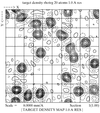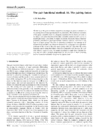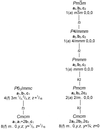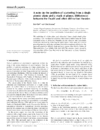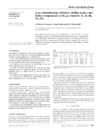issue contents
March 2001 issue

Cover illustration: Graphical representation of density modification due to third-order terms b113 = -b223 (point group ![]() ) in the Gram-Charlier series expansion of a Gaussian atomic probability density function. Courtesy of W. F. Kuhs.
) in the Gram-Charlier series expansion of a Gaussian atomic probability density function. Courtesy of W. F. Kuhs.
research papers
A new statistical approach to direct methods is based on a unique many-body ensemble in which specific long-range pairing forces act between the atoms. The forces are derived from the direct correlation function of the ensemble.
A new direct method is implemented in a simple peak-picking algorithm that alternately searches for well paired clusters of atoms and generates a new map from the strong reflections. The method solves small real molecules of up to 200 atoms. It also solves ideal point-atom models on a grid, with 600 atoms ab initio and 30000 atoms when guided by a small known fragment.
The pairing force needed to guide atoms into a structure solution is estimated by many-body theory in terms of the direct correlation function. Simple approximate formulae are derived from the Gaussian distribution, valid for all space groups. The theory is extended to treat different types of atom.
An exponential modeling algorithm is developed for protein structure completion by X-ray crystallography and succesfully tested on experimental data. The Bragg reflections are phased by repeated cycles of real and reciprocal phase constraints and cross validation by means of a free R factor.
The transformation from the wurtzite to the NaCl type is described by means of a deformation of a heterogeneous sphere packing. The proposed mechanism corresponds to a displacive transition without breaking bonds.
The most complex structure, of Ti45Se16, which contains 122 atoms per unit cell, has been determined from selected-area electron diffraction data using the quasi-kinematical approach. Conditions that facilitate successful application of the quasi-kinematical approximation for electron diffraction data are discussed
The linear polarization of synchrotron radiation is explored as a tuning key for the strength of simultaneously diffracted waves in crystals. It improves the applicability of the multiple-diffraction phenomenon for materials analysis and allows the linear polarization state of an X-ray beam to be measured from a single azimuthal scan.
Spatial coherence is estimated quantitatively from the equal-thickness fringes by correcting the effect of the dynamical absorption.
Generalized extinction factors as a function of wavelength are obtained from measurements of integrated diffracted powers by utilizing a weak reflection for scaling. The results are compared with theoretical predictions for a perfect bipyramidal crystal.
The scattering of a scalar plane wave (neutrons) from a single atomic plane consisting of any two-dimensional lattice with a basis is studied using the Ewald dynamical theory of diffraction. Results derived are valid for general geometries of incident and exit beams and the structure factor obtained differs from that used in the kinematic or Laue dynamical diffraction theories.
short communications
Debye–Waller factors of five h.c.p. elements (Ti, Zr, Ru, Tm, Hf) have been determined from X-ray diffraction intensities. The energy of formation of vacancies (Ef) has been estimated from a semi-empirical relation between Ef and θ.


 journal menu
journal menu










